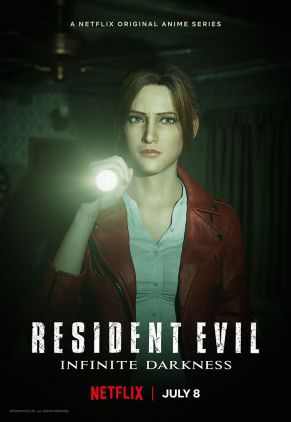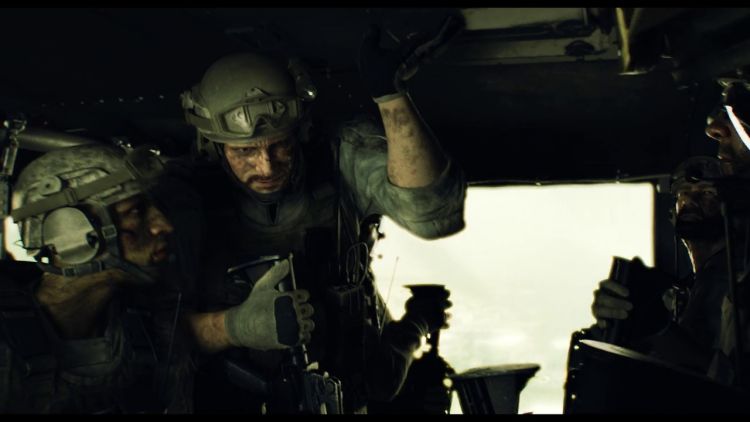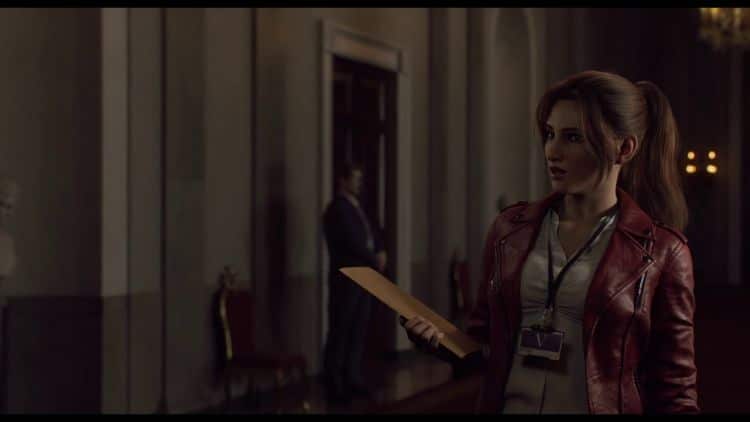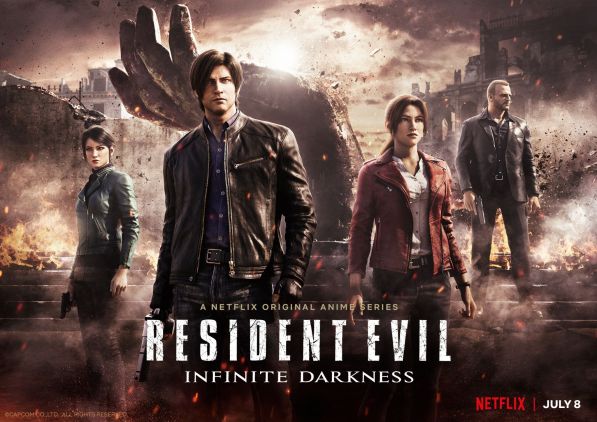My god Resident Evil, you have become so insanely formulaic that you can use a freaking Madlib to work out how the story and action are going to go with these side-story movies, and yes, Resident Evil: Infinite Darkness is a movie. Don’t let the Netflix TV show style fool you, Resident Evil: Infinite Darkness was designed, produced, and pretty much scripted as another one of the Resident Evil movie series films. What we get in Resident Evil: Infinite Darkness is another side-story movie that shows why the games, which have moved onto bigger and better ideas, are doing so well while things like Resident Evil: Infinite Darkness are becoming boring and predictable.

Production Company: TMS Entertainment
Distributed by: Netflix
Directed by: Eiichirō Hasumi
Produced by: Hiroyasu Shinohara
Written by: Eiichirō Hasumi & Shogo Moto
Starring: Nick Apostolides, Stephanie Panisello, Ray Chase, & Jona Xiao
Based on: Resident Evil by Shinji Mikami
Release dates: July 8, 2021
Running time: 25–28 minutes
AUTHORS NOTE: Ok, before I get into this, I feel like I’m going to need to preface this by explaining to the ravenous hordes of Resident Evil fans out there, much like the ones who ripped into me for not giving Resident Evil VII: Biohazard a glowing review, that I LOVE Resident Evil. Resident Evil is my favorite gaming series out there, something that I play time and time again in my downtime. I spend hours, days, months, years, going over lore videos, documents, and other things in order to dive deeper into the story of Resident Evil than most other people ever do. I own all the games, books, comic books, archives, CGI movies, and also live-action movies. If there is anything Resident Evil related to review, I’m the guy that The Outerhaven, and some other sites, goto when things need to be reviewed. While the following is going to come off quite harsh towards a decent series, I do it out of love for the franchise, and a wish to see the movies evolve much as the game has. So do not come after me in the comments or via email saying that I’m just a Resident Evil hater, because I am far from that.
Now… It has been some time since we last had a Resident Evil CGI film, with Resident Evil: Vendetta coming out in 2017. Keeping in line with this movie series idea of jumping around everywhere on the timeline, Resident Evil: Infinite Darkness takes us back to the time after the events of Resident Evil 4, but before the events of Resident Evil 5 (A still highly underrated game in my opinion).
Resident Evil: Infinite Darkness does its best to take on 2.75 stories at once. The first story is coming from Jason, the “hero of Panamstan”, whose whole squad got infected with the T-Virus after a mission to the war-torn region and rescuing a fellow US soldier who was already infected. Jason’s arc here is the usual one for the pseudo-villain of Resident Evil: Infinite Darkness, he wants to expose what the US Government has been doing with the Virus and also Bioweapons. Jason is joined by Shen May, a fellow US Soldier whose brother was the one Jason rescued (though the brother died and turned into a zombie during the incident). This story flows into the “real bad guys” story where Senator Wilson is trying to persuade the US President to send the military into Panamstan in order to put pressure on the Chinese and bring them to war, claiming that the Virus used in Panamstan was created by the Chinese (Sound familiar? It was CHI-NA) when really it was Wilson working with TerraSave to create a new batch of Bioweapons.

In the course of this main story, we see Claire Redfield get involved due to seeing a drawing by a child who is in Panamstan which featured an event during Jason’s time in the region, involving zombies. Fearing another outbreak, Claire heads to the White House to find out what happened in Panamstan and why. Obviously getting nowhere as Governments aren’t exactly going to go on record about such events. Leon is also at the White House too after being summoned by the President as an expert in matters involving zombies and other phenomena thanks to his recent mission to rescue Chelsea, the President’s Daughter, in Resident Evil 4.
Over the course of 4 episodes, we follow both Leon and Claire as Leon gets involved with Jason and Shen May through the couple’s deception to use the US Government to get into one of the TerraSave labs and put a stop to the Bioweapon production and expose Senator Wilson and his actions. Leon comes off as very hesitant here, as this is not the first time he has seen this type of plot, and the same can be said of the viewer, as this plot feels like the same one used in the first Resident Evil CGI film: Resident Evil: Degeneration, complete with Jason becoming a Tyrant-Like Bioweapon himself and wanting to show himself to the world so that will force the US Government to admit the truth and create terror amongst the population of the world.

The theme of the difference between “Fear” and “Terror” plays a big role in the events of Resident Evil: Infinite Darkness. We see Jason’s fear get the better of him, causing him to become something that can be used to spread terror to the world. Leon is fearful of the terror that can be created should the truth of what the US Government is doing gets out, making him play a protector role that feels very off-putting for anyone who has played Resident Evil 2 and knows his backstory. Shen May’s feat of losing her brother to the virus makes her go along with Jason’s plan but dies knowing the terror that Jason wants to instill into the world caused him to betray her. Claire… Well, she is just there honestly, put onto the back burner once Jason’s plan becomes the focus after episode 2.
Honestly, Resident Evil: Infinite Darkness really shows how by-the-numbers the Resident Evil CGI franchise has become. Where Resident Evil Village is innovating with things like the House Beneviento scenario, bringing true horror back into the games, Resident Evil: Infinite Darkness just plays things safe, almost remaking Resident Evil: Degeneration in parts. We have two main characters from one of the most popular entries of the games reunite, there’s a conspiracy going on, there’s a guy who is willing to sacrifice his life by turning into a Bioweapon to expose the truth, and everything ends in an underground laboratory that is needing to be destroyed in order to stop the Bioweapon. We’ve seen these scenarios play out way too many times in games, movies, and books for it to feel exciting anymore.

Though a highlight of Resident Evil: Infinite Darkness is the animation itself, for the most part. Resident Evil: Infinite Darkness really shows that the CGI animation that has been used to create these movies has come a long way since Resident Evil: Degeneration, with the use of Ray-Tracing technology being apparent here, to the point where my fiance was able to notice small details, like the freckles on Claire’s face and the dust particles moving around in a beam of light. Some really impressive stuff on display here. However, there is a small downside that really got to me by the end of the movie, and that was the mouth movements. I think, much like previous entries into the Resident Evil CGI movie series, Resident Evil: Infinite Darkness was produced with the Japanese audio in mind first, then was overdubbed in English. At times, this overdub gets really noticeable during longer conversations, with mouth movements not quite matching up with the words coming from the characters. It’s a small gripe, but enough to take me out of some really needed exposition dumps.
As a Resident Evil fan, I’m more than happy to sit down and watch more stories set in the pre-Ethan Winters era, but when you see that the Resident Evil games have managed to grow and evolve, much like a virus, watching Resident Evil: Infinite Darkness felt more like a chore, a repeat of everything I already knew and seen before. Resident Evil: Infinite Darkness does nothing new in its 4 episodes and closes itself off so you know this won’t have a season 2. I feel this was Netflix doing what it does best, throw money at a franchise to get something exclusive on the platform and using the name value to draw in viewers.

Resident Evil: Infinite Darkness does not have the scares, motives, or character development that other films have done in the past, it’s a safe play that was done so that Netflix could get the name rights for something different that they make without CAPCOM being involved while giving CAPCOM some sweet streaming platform money to use for something else. Resident Evil fans might want to debate me on this, but Resident Evil: Infinite Darkness just really wasn’t needed. I hope that CAPCOM would like to expand other parts of the franchise, use other characters like Jill Valentine, Carlos, Chris Redfield, or hell… I’ll take Ethan Winters at this point just so we can get something different with these movies.
Resident Evil: Infinite Darkness
Summary
Resident Evil: Infinite Darkness brings back Leon Kennedy and Claire Redfield once again to face off against the undead, bioweapons, and a conspiracy… YAWN! Resident Evil: Infinite Darkness is a safe, by-the-numbers, Resident Evil story that does not bring in any thrills, scares, or excitement. The games have evolved to using new characters, new ideas, and new techniques to bring survival horror back, but this CGI movie series is stuck in the same spot it started with. It’s time to move onto other characters and other parts of the timeline to tell better stories than what we got here.
Pros
- Animation still impresses
- More Resident Evil side-stories are good
- Doesn’t mess with established lore
Cons
- The story is a repeat of Resident Evil: Degeneration
- Claire is sidelined too quickly
- Plays things too safe in all departments


